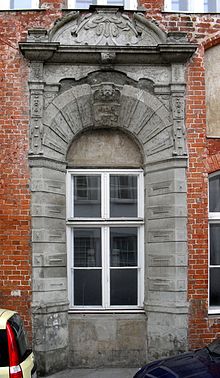Schildstrasse 10
The house at Schildstrasse 10 in Schildstrasse in Lübeck's old town is a listed former brick renaissance house .
building
The property is near the Aegidienkirche and had the old house number Johannis Quartier 693 . It was first mentioned in 1302 and was built as a curia (courtyard) in 1326 . The roof structure is dendrochronologically dated to 1444/45. Today the street side shows a Renaissance stepped gable which was digested in the Baroque style during the 18th century. In the course of this, the cladding of the gable was shortened in the upper area. The mannerist sandstone portal was once created by Robert Coppens . In the later major changes, the entrance in the portal was walled up and provided with a window. The high windows of the hall level were covered in the upper part. The entrance was moved to the left side of the house and the building was integrated into the school building on the right. The exterior of the house, especially the portal, has been a listed building since 1967.
owner
The house has had numerous prominent residents over the centuries. One of the earliest was the mayor of Lübeck, Thomas Morkerke , at the end of the 14th century , who also belonged to the patrician circle society . The Lübeck councilor Bernhard Darsow bequeathed Schildstraße 10 in 1479 through his daughter to her husband, the later Lübeck mayor Johann Hertze , who lived here until his death in 1510. Then it was the home of the son-in-law of another Darsow's daughter, the Lübeck city governor in Mölln, Gottschalck Lunte , who briefly became mayor under Jürgen Wullenweber . After Lunte's death, Schildstrasse 10 passed through his daughter as an inheritance to his son-in-law, councilor Franz von Stiten . In the middle of the 17th century the house belonged to the Lübeck merchant and councilor Adrian Müller and was therefore given the name Das Lange Haus der Müller .
In 1737, Landgrave Karl I von Hessen-Philippsthal , a lieutenant general in Danish, but temporarily also in French services, acquired Schildstrasse 10, which gave the house the name Das Landgräfliche Haus . He allowed the Reformed Congregation, whose new church building in front of the city was not yet fully completed, to hold their services here in December 1737. Since all public non-Lutheran church services within the city walls were illegal, the Lübeck Council, following a complaint by the Ministry of Spiritual Affairs , prohibited these services by decree of December 18, 1737 under threat of harsh measures ; on the other hand, the landgrave was allowed to worship privately in his apartment. During the Seven Years' War the Landgrave temporarily took refuge here in neutral Lübeck. The daughter of Landgrave Charlotte Amalie von Sachsen-Meiningen inherited it after his death in 1770; from 1773 to 1784 she was the owner of the house, now called Der Fürstenhof .
The Hanseatic City of Lübeck has owned the building at Schildstrasse 10 since 1788 and used it primarily for public administration purposes. First as a pawnshop since 1789 , then as a private advance payment institution ( Sparkasse ). In 1893 the structural integration into the neighboring school building took place. It was the seat of the Lübeck calibration office until 1939 and the Brockensammlung from 1913 to 1916 . From 1910 until the end of the First World War it was also the column house of the medical column from Rothen Kreuz . It was later used again as a school building for the August Hermann Francke School .
At that time, the entrance was put out of action and an entrance that was already out of order was created to the right of it.
literature
- Wilhelm Brehmer : Lübeck house names. HG Rathgens, Lübeck 1890
- Emil Ferdinand Fehling : Lübeck Council Line. Lübeck 1925, nos. 392, 571, 627, 678
- Klaus J. Groth : World Heritage Lübeck - Listed Houses. Over 1000 portraits of the listed buildings in the old town. Listed alphabetically by streets. Verlag Schmidt-Römhild, Lübeck 1999, p. 380. ISBN 3-7950-1231-7 .
- Monika Schedel (restorer): Lübeckische Blätter , edition 08/2012, article: Forgotten house stone portals
Individual evidence
- ^ Wilhelm Deiß: History of the Evangelical Reformed Congregation in Lübeck. 1866. ( digitized version ), p. 158
- ^ Johann Rudolph Becker : Complicated history of the kaiserl. and salvation. Roman Empire freyen city of Lübeck. Volume 2, Lübeck 1784, p. 298
- ↑ During the Seven Years' War, the Hoghehus in Lübeck was also the "alternative residence" of Duke Friedrich the Pious from 1761 to 1764 , who, as a precaution, had already moved to Lübeck with his court in 1757 and ruled his state Mecklenburg-Schwerin from there with his ministers . Compare: Otto Vitense : History of Mecklenburg, p. 303.
- ^ Johann Rudolph Becker: Circumstances History ... , Volume 3, Lübeck 1805, p. 378.
- ↑ according to consolidation of the Lübeck address books
Coordinates: 53 ° 51 ′ 50.1 ″ N , 10 ° 41 ′ 18.2 ″ E



